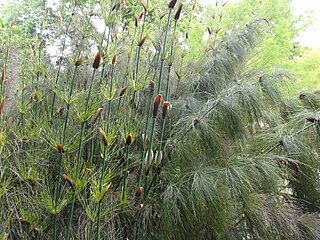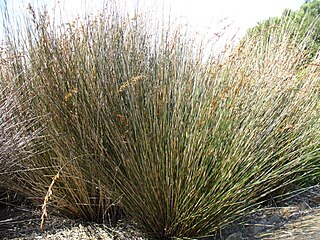| Thamnochortus | |
|---|---|
 | |
| Thamnochortus cinereus | |
| Scientific classification | |
| Kingdom: | Plantae |
| Clade: | Tracheophytes |
| Clade: | Angiosperms |
| Clade: | Monocots |
| Clade: | Commelinids |
| Order: | Poales |
| Family: | Restionaceae |
| Genus: | Thamnochortus P.J.Bergius |
| Type species | |
| Thamnochortus fruticosus P.J.Bergius [1] | |
Thamnochortus is a group of plants in the Restionaceae described as a genus in 1767. [1] [2] The entire genus is endemic to Cape Province in South Africa. [3]
- Species [3]
- Thamnochortus acuminatus
- Thamnochortus amoena
- Thamnochortus arenarius
- Thamnochortus bachmannii
- Thamnochortus cinereus
- Thamnochortus dumosus
- Thamnochortus ellipticus
- Thamnochortus erectus
- Thamnochortus fraternus
- Thamnochortus fruticosus
- Thamnochortus glaber
- Thamnochortus gracilis
- Thamnochortus guthrieae
- Thamnochortus insignis
- Thamnochortus kammanassiae
- Thamnochortus karooica
- Thamnochortus levynsiae
- Thamnochortus lucens
- Thamnochortus muirii
- Thamnochortus nutans
- Thamnochortus obtusus
- Thamnochortus paniculatus
- Thamnochortus papyraceus
- Thamnochortus pellucidus
- Thamnochortus platypteris
- Thamnochortus pluristachyus
- Thamnochortus pulcher
- Thamnochortus punctatus
- Thamnochortus rigidus
- Thamnochortus scabridus
- Thamnochortus schlechteri
- Thamnochortus spicigerus
- Thamnochortus sporadicus
- Thamnochortus stokoei
- formerly included [3]
moved to other genera: Cannomois Hypodiscus Restio Rhodocoma Staberoha
- T. aemulus - Staberoha aemula
- T. argenteus(Thunb.) Kunth 1841 not Pillans 1928 - Hypodiscus argenteus
- T. cernuus - Staberoha cernua
- T. debilis - Restio debilis
- T. distichus - Restio distichus
- T. giganteus - Rhodocoma gigantea
- T. imbricatus - Staberoha distachyos
- T. imbricatus var. stenopterus - Staberoha cernua
- T. membranaceus - Restio distichus
- T. micans - Restio micans
- T. modestus - Rhodocoma fruticosa
- T. occultus - Restio occultus
- T. robustus - Cannomois robusta
- T. scirpoides - Cannomois scirpoides
- T. strictus - Cannomois parviflora
- T. umbellatus - Staberoha distachyos
- T. virgatus - Cannomois virgata












